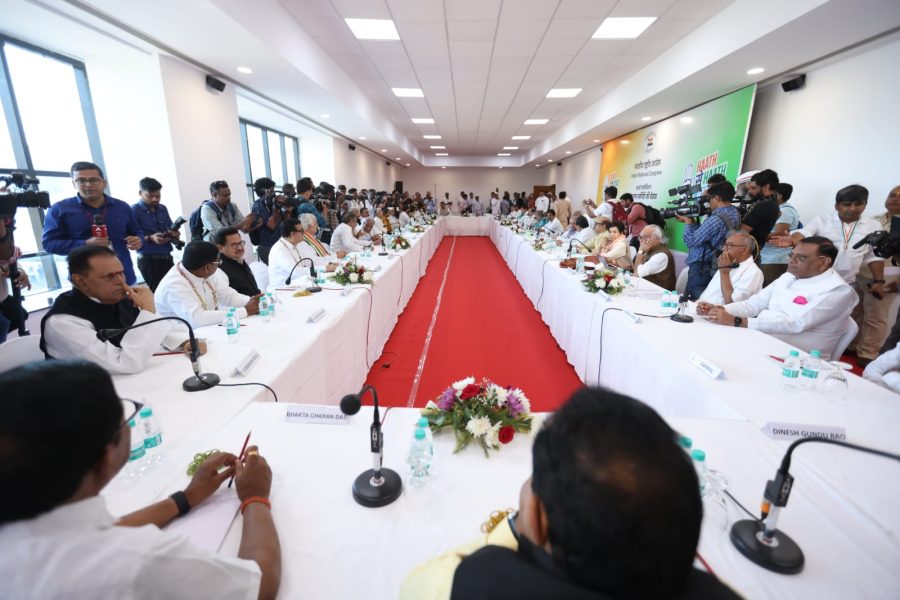
Cong economic resolution: 'Party's task now to lift bottom 50% of population'

The Congress on Saturday (February 25), the second day of its 85th plenary session in Raipur, unanimously passed its draft economic resolution after senior leader P Chidambaram summed up its highlights. The former finance minister said the party’s task would be to “lift the bottom 50 per cent” of the population, which the BJP would not do because it “believes in the concentration of wealth in a few hands.”
Chidambaram conceded that while the economic policies of the Congress governments of 1991 and 2004 created immense wealth and doubled the country’s GDP twice, wealth distribution was not equitable and that “there is no harm in admitting this”. He stressed from now onwards, the Congress must present an economic policy for the future, which, just as its earlier economic policies created work and wealth for the top 50 per cent of the population, should now create wealth and work for the bottom 50 per cent.
“We must adopt the 50 percent of the bottom of the population as our constituency and say that the Congress party’s task is to lift the bottom 50 percent… We are a very unequal society… This inequality will lead to political instability and social strife… We must not hesitate, not flinch or be afraid to openly declare that from this day onwards the Congress’s economic policies will create work and create wealth but will ensure that it is equitably distributed so that the bottom 50 per cent of the population will get the most benefit over the next 10 to 20 years.”
Also read: Congress reserves 50% seats for SC/ST, minorities, women, youth on CWC
He added that “the BJP will not do that; the BJP believes in cronyism; the BJP believes in concentration of wealth in a few hands, the BJP believes in creating monopolies.”
Focus on job creation
In line with that vision, the Congress’ economic resolution focuses on re-setting its economic policies to “reiterate the advantages of an open, market economy, support wealth creation, reduce inequality between the rich, the middle classes and the poor, and accelerate growth driven by the private and viable public sector enterprises.”
The party believes that “jobs” should be the main focus of its economic policy. Reiterating its commitment to “fill all vacancies in government and semi-government bodies, the Armed Forces, the para-military forces and public sector undertakings immediately,” it also emphasises the need to give full support to MSMEs, “the biggest employers employing 12 crore people,” so that these can grow and expand.
The resolution also states the need for creating an “Urban NREGA, similar to MGNREGA” to provide a safety net for the urban poor and providing loans to self-help groups (SHGs) that will “create thousands of jobs.” Focusing on growing inequality, the resolution says, “We must demand more allocations for health and education, a reduction in consumption taxes that affect the poor more, and higher taxes on the wealthiest people.”
Also read: Congress plenary in Chhattisgarh: No polls; Kharge to nominate CWC members
While talking about rising inflation, the resolution re-affirms the party’s support for “a Universal Basic Income for every low-income family” and the NYAY scheme “that was first promised in the Congress Manifesto 2019,” besides a host of other welfare measures for women, children, farmers, unemployed people, migrant labourers, among others.
The draft resolution also mentions the need to push green energy and proposes the need for “massive capital expenditure (Green CAPEX) for our green energy transition.”
Adani and “private monopolies”
One of the targets is “preventing open loot of public exchequer to fund crony capitalists and establishment of private monopolies,” which starts with the mention of Adani Group and the developments in the wake of the Hindenburg Research report. “The Indian National Congress and the people of our country are determined to unearth the truth about how one group with doubtful credentials and alleged links with tax haven-operated offshore shell companies has monopolized critical assets of India,” the draft says.
The resolution also repeats the promise from the Congress Manifesto 2019 that “disinvestment will be confined to chronic loss-making PSUs and non-core, non-strategic PSUs” with the funds thus generated to be “parked in a Fund dedicated to make investments in improving the quality of education, healthcare, and research and development (R&D).”
Also read: Difficult struggle ahead but victory will be ours: Sonia Gandhi at Congress Plenary
Another target is to improve Centre-state fiscal relations, for which the party “recognizes the merit of decentralizing planning, execution, and expenditure to the State, District, and Panchayat levels.” The resolution also covers the falling value of INR, which “ended 2022 as the worst-performing Asian currency” and the expanding government debt.
New vision
Finally, presenting “A New Economic Vision for India,” the resolution says, “The Congress Party will herald a new beginning, just as we did in 1991, involving all sections of the people in nation-building.”
“Our new economic vision and action will be recrafted from the current excessive focus on capital and move more towards labour. Every decision will be evaluated with what it brings to people in terms of jobs, incomes, healthy living standards, and livelihoods.”
The resolution ends with the following lines, “Creation of jobs should be the primary benchmark for evaluating all policy options, not mere production. Tax policy should be reoriented towards employees and wages, besides investments and profits. Trade is critical for us as a labour surplus nation. India’s economic vision needs a fundamental shift with all the factors of production as the foundation for development. With this new economic vision, we aim to build a fair, just, and equal economy and bring opportunity and prosperity to all sections of the people.”

